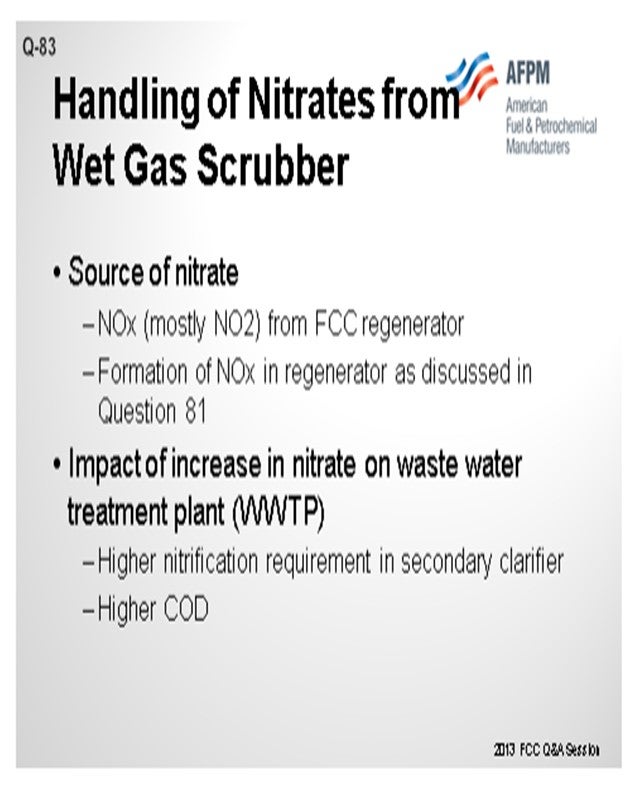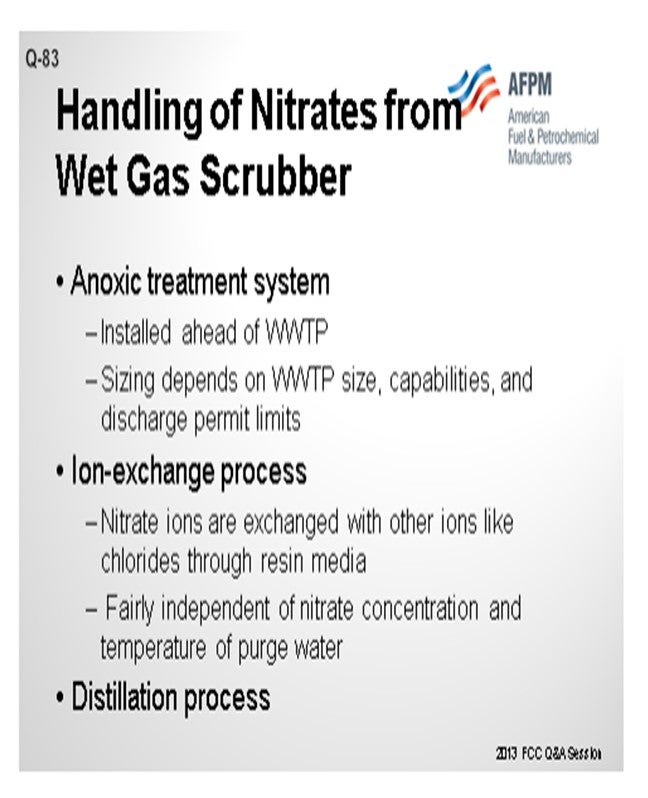Question 83: Wet flue gas scrubber NOx removal technology often results in excessive nitrates in the purge water. What are refiners doing to limit nitrates going to their wastewater treatment plant?
GIM (Technip Stone & Webster)
Nitrates and nitrites are inevitable byproducts from the removal of NOx from FCC flue gas. Obviously, one way to lower this nitrate concentration going into the purge water is to reduce the NOx in the flue gas, which we discussed a couple of questions ago. So, assuming that we have done everything possible to reduce the NOx in your flue gas, we will then need to look at 1) the impact of nitrates in the wastewater treatment system and 2) some of the solutions available to address the increase of nitrate in the purge stream to the wastewater treatment plant. After I go through this formal response, I think it will be helpful to open up the floor for feedback of any experiences you all may have. It will be a great way to address this particular question in more detail.
The incremental introduction of nitrates can bring imbalance to the existing wastewater treatment plant, which has its own set of capacity limitations, peaks, and valleys. There are several options and practices for pre-treating this purge stream ahead of the wastewater treatment plant, which becomes very important; because in some areas of the country, more stringent NOx regulations are in effect. Additional purge water will increase effluent sodium concentration. Also, the increase in nitrate concentration will increase the likelihood of higher nitrification in the secondary clarifier, which may result in exceeding the chemical oxygen demand (COD) permit limits.

One refiner has addressed the increase in nitrate by modifying its existing aeration basin in the wastewater treatment plant. An anoxic (not anabolic) treatment system was used to metabolize the NaNO3 (sodium nitrate) by utilizing oxygen from the NaNO3 itself; hence, termed anoxic as opposed to aerobic or anaerobic.
An anoxic tank was used ahead of the refinery wastewater treatment plant to initially treat the wet gas scrubber purge stream. The sizing and treatment of the anoxic tank is heavily dependent on the temperature of the purge water, as well as the size of the existing wastewater treatment plant and its permit limits. In this specific example, a 75% removal of the nitrate in the purge stream was achieved.
There are a couple of other smaller-scale industrial application options. Ion exchange is one of the technologies used to remove nitrates. Nitrate ions are exchanged with other ions, like chlorides, through a resin media. The benefit of this is that it is fairly independent of the concentration and temperature of the purge water, unlike the previous example I just mentioned. Simple distillation processes can also be incorporated ahead of the wastewater treatment plant to concentrate the nitrates and other minerals and send the treated water downstream.

ROBERTSON (AFPM)
That is the response for this question. Are there any other comments or questions from the audience? This question was a little exotic in its nature, so we are hoping that some other operators or people will share their experiences.
MICHAEL WARDINSKY (Phillips 66)
I am curious to know if this issue of having to revamp your wastewater plant has shifted anyone’s flue gas treatment options back to an SCR (selective catalytic reduction) or SNCR (selective non-catalytic reduction) versus a technology like LoTOx™ where you take the NOx, convert it into nitrate, and then put it in the wastewater. Did that change anyone’s approach to removing NOx from the flue gas?
BULL (Valero Energy Corporation)
We have various LoTOx™ applications, which were just taken into account during the design phase. We did not have to add equipment after startup. So as far as the capital cost for the full project, it did not have a significant impact.
STEVE GIM (Technip Stone & Webster)
Source of Nitrate: Nitrates and nitrites are inevitable byproducts from the removal of NOx from the FCC flue gas. One obvious way to reduce the number of nitrates is to reduce the source of NOx. This subject has been extensively discussed in many of the previous FCC panels. This question was not chosen from the original list. Some of the main parameters are combustion kinetics in the regenerator (excess oxygen level, temperatures, promoters, and CO level), FCC hardware (regenerator designs, air/catalyst distribution, and stripper efficiency), and, to some degree, the nitrogen content of the fresh feed to FCCs. We will cover the nitrates produced from the wet gas scrubber, assuming you have done everything you can to control the source of NOx. I appreciate our colleagues from Belco for their contribution of additional input addressing some of the salient issues surrounding the treatment of the nitrates.
Impact of Increase in Nitrate on Wastewater Treatment Plant: Incremental introduction of nitrates can bring imbalance to the existing wastewater treatment plant with its own set of capacity limitations and peaks and valleys. Technology options and practices for pre-treatment or rerouting of the purge water ahead of the wastewater treatment plant becomes important, especially in regions where more stringent NOx regulations are prevalent. Additional purge water will increase effluent sodium concentration. The increase in the nitrate concentration can also increase the likelihood of higher nitrification in the secondary clarifier, which may result in exceeding chemical oxygen demand (COD) permit limits.
Example of Nitrate Reduction Ahead of Wastewater Treatment Plant: One refiner addressed the increase in the nitrate by modifying his existing aeration basin in the water treatment plant to eliminate the problem. An anoxic (not anabolic) treatment system can be used to metabolize the NaNO3s by utilizing the oxygen from the NaNO3 itself; hence, the term anoxic (utilization of the inherent stream chemistry absent of an outside oxygen source), as opposed to aerobic or anaerobic.
An anoxic tank was used ahead of the refinery wastewater treatment plant to initially treat the wet gas scrubber purge stream. Anoxic tank sizing/treatment is very dependent on temperature. Every application would be different due to location and, even more importantly, the specific refineries wastewater treatment plant sizing, capabilities, and discharge permit limits. In this specific example, near 75% removal of nitrate was achieved.
In smaller scales, a couple of other options are available in other industrial application of nitrate removal. Ion exchange is one of the frequently used technologies for removal of nitrates. Nitrate ions are exchanged with other ions, like chlorides, through resin media. It is fairly independent of nitrate concentration and temperature of the purge water. A distillation process can also be incorporated to concentrate nitrates and other mineral contaminants, while sending the most the treated water downstream.
TINA SYVERT (Nalco Champion Energy Services)
Removal of nitrogen in refinery effluent water relies on biological processes. Nitrates can be handled by modifying a secondary treatment system with an anoxic reactor upstream of an aerobic reactor. The activated sludge-containing nitrates formed in the aerobic reactor as a result of the nitrification process (ammonia to nitrate) are returned to the anoxic zone where they are converted to nitrogen gas.